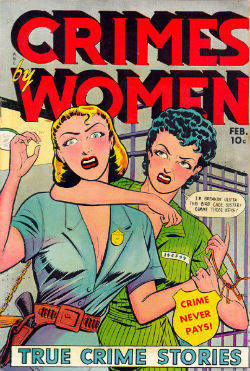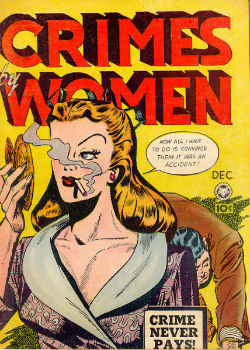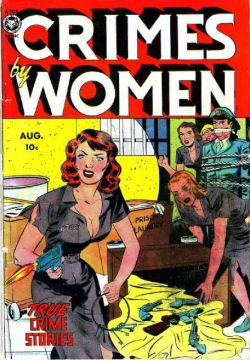 Crimes By Women was a ten cent comic book published by the Fox Features Syndicate from June of 1948 to August of 1951. It was an anthology series that showcased a series of femme fatales, gun molls and full-tilt psychopaths engaged in all manner of sexual seduction and wanton violence. It was, in a word, trash.
Crimes By Women was a ten cent comic book published by the Fox Features Syndicate from June of 1948 to August of 1951. It was an anthology series that showcased a series of femme fatales, gun molls and full-tilt psychopaths engaged in all manner of sexual seduction and wanton violence. It was, in a word, trash.
Trash has its appeal, though, and—more importantly—it can tell us something about the shifting currents of a culture.
Fox Features Syndicate was the brainchild and ongoing concern of one of the most interesting figures in the early days of comic books. Victor Fox was a Russian immigrant who had been born in England before his family settled in America in 1898. Short (only about 5’2”) and bursting with energy, Fox had an obscure early life that was later shrouded in myth. There was talk of a career as an illegal boiler-room stock trader, of a conviction for mail fraud, of a side job as an accountant for National Allied Publications (which later became DC Comics) that gave him the idea to start his own business ripping off his old bosses. (Comics legend Jack Kirby, who later worked for Fox, compared him to movie gangster Edward G. Robinson.)
 What is certain is that Fox was quick to jump on the superhero bandwagon that had begun with Superman. He didn’t bring a lot of artistry or originality to the job. After starting Fox Features in 1939, he quickly gave the world Wonder Man. The comic was never more than a cheap rip-off of the Man of Steel, though, and Fox was later sued successfully for copyright infringement.
What is certain is that Fox was quick to jump on the superhero bandwagon that had begun with Superman. He didn’t bring a lot of artistry or originality to the job. After starting Fox Features in 1939, he quickly gave the world Wonder Man. The comic was never more than a cheap rip-off of the Man of Steel, though, and Fox was later sued successfully for copyright infringement.
Fox had more success with the character of a cop turned crime fighter called Blue Beetle. For while, Blue Beetle was to Fox Features what Batman is to DC today. He was everywhere, in multiple titles. (He also had his own radio show, voiced by the great film noir everyman Frank Lovejoy.) Throughout the 40s, Blue Beetle was Fox Features.
After the war, though, the interest in superheroes saw a sharp drop in popularity as the tights-and-capes fantasy went out of fashion and a newer, grittier form of fantasy took its place. Just as Fox had followed the trend of caped crusaders, so he now followed the rise of crime-based urban drama with titles like Almanac of Crime, Famous Crimes, and Murder Incorporated.
 Crimes By Women was maybe the purest example of the Fox pulp trash aesthetic. Geared toward the audience that was devouring pulp novels and the never-ending series of crime pictures rolling out of the Hollywood B-units, the comic privileged movement and violence over plot. Characterization was thin even by the standards of a late forties comic books. The favored punctuation was the exclamation.
Crimes By Women was maybe the purest example of the Fox pulp trash aesthetic. Geared toward the audience that was devouring pulp novels and the never-ending series of crime pictures rolling out of the Hollywood B-units, the comic privileged movement and violence over plot. Characterization was thin even by the standards of a late forties comic books. The favored punctuation was the exclamation.
Its usual pattern was to feature one story based on a real case, followed by two or three new tales. The lead stories were “based” on real cases in only the loosest sense. The first issue, for example, showcased “The True Story of Bonnie Parker, Queen of the Gun Molls!” What’s fascinating about this retelling of the story of Bonnie and Clyde is that Bonnie is the leader of the gang. After meeting Clyde and a friend at the diner where she works, she immediately ditches her job (“Let’s get outta here! Another minute in this greasy spoon and I’ll vomit!”) and sets them on a crime spree (“How about a rod for me? If I’m gonna be in the mob, I’m gonna be in it…all the way!”). There’s no other version of this story where Bonnie calls all the shots. She hatches the scheme for the first job, she makes them upgrade their ride by stealing another one (she gives the car’s owner, an older man, a vicious pistol-whipping), she kills two people during their first job (Clyde: “Ya don’t have to knock off everybody ya see do ya?”), and she kills a man who asks her not to smoke one of her ubiquitous cigars on a dance floor. She’s a gun-toting, cigar-chomping, expletive $#@!ing sociopath.
Interestingly enough, the first issue of Crimes By Women is notable for being rather low on the number of women committing crimes. After Bonnie Parker goes out in a blaze of gunfire, the other stories in the book are more male-centered, as if the makers weren’t quite sure if the audience simply wanted, well, crimes by women.
By the second issue, apparently this question had been answered because the bad girls take over and wreck havoc. The showcase true story featured “Belle Guness [sic], the Monster of LaPorte” about the black widow serial killer. This version of Belle Gunness is a typical Crimes By Women protagonist. Three panels into the first page of the story, she decides to kill her first husband, noting, “It’s about time I got rid of that miserable excuse for a man and now’s the time to do it!” The circular construction of that line should amply demonstrate the editorial care that was lavished on this comic. It can be wickedly funny though. Upon planning the murder of one husband, Belle thinks, “I’ll probably ruin my new dress, but it’ll be worth it.” In Belle’s defense, though, most of her husbands are drunken louts. She kills her victims not with anything as dainty as poison. She’s a more of an axe/cleaver/blunt object kind of gal. All while showing a lot of leg.
Over the next thirteen issues of Crimes By Women, the black spiders pile up. We get “Anna Slayne, Flower of Evil” and “Jean Torson, Satan’s Daughter.” We meet such shrinking violets, both real and imagined, as “Radiant Jade, The Devil Incarnate,” “Memphis Mae Corey, The Dixie She-Devil With The Face Of An Angel And A Heart Full Of Hate,” “Bull’s-Eye Beatrice,” “Jo Ardway, Roadside Murderess” and, of course, “Ma Barker, Killer!”
As is often the case with comics from this era, the talent working on the books was mostly anonymous. Some of the artists we know to have worked on the series, however, included A. C. Hollingsworth (one of the first African American artists to work in comic books) Warren Broderick, Jimmy Maxwell, and Jack Kamen.
Crimes By Women was no one’s idea of a masterpiece. It was neither subversive proto-feminism nor an ironic take on misogynist fears of powerful women. Though it was made with a certain degree of wit and skill (especially in the art), it was pretty much just trash. But it does tell us something interesting about comics at the time.
The trend toward more explicit subject matter after World War II created its own backlash as more and more people called for comics to be censored. In his book Evil Influences: Crusades Against the Mass Media the author Steve Starker notes that by the end of the 1940s, nearly 50 American cities had attempted to ban comic books. Soon, the newly formed Comics Code would strip comics of much of their grit and bite. Sex and violence were out. Comics got neutered for a generation. There was a period there, however, in the postwar fallout, where the images of women being not just bad but completely homicidally insane had enough of an audience to merit their own comic book. Make of that what you will.
Jake Hinkson is the author of several novels, including the newly-released The Big Ugly.

PS. A great place to check out issues of CRIMES BY WOMEN is [url=http://digitalcomicmuseum.com/index.php?cid=843]The Digitial Comic Musem[/url].